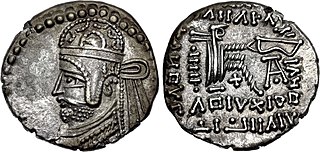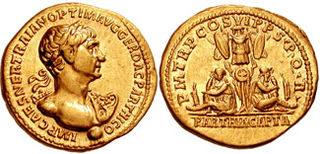
Parthamaspates was a Parthian prince who ruled as a Roman client king in Mesopotamia, and later of Osroene during the early second century AD. He was the son of the Parthian emperor Osroes I. [1]

Parthamaspates was a Parthian prince who ruled as a Roman client king in Mesopotamia, and later of Osroene during the early second century AD. He was the son of the Parthian emperor Osroes I. [1]
After spending much of his life in Roman exile, he accompanied the emperor Trajan on the latter's campaign to conquer Parthia. Trajan originally planned to annex Ctesiphon as part of the Roman Empire, but ultimately decided instead to place Parthamaspates on his father's throne as a Roman client, doing so in 116. [2] Trajan effectively crowned Parthamaspates as a king of Parthia. [3]
Following Roman withdrawal from the area, Osroes easily defeated Parthamaspates and reclaimed the Parthian throne. [1]
After his defeat in Parthia, Parthamaspates again fled to the Romans who then, as a consolation, granted him the co-rule of Osroene, a small Roman client state between Asia Minor and Syria. He was king of Osroene together with Yalur from 118 to 122, and afterwards sole ruler to 123. [1]

From his territory of Osroene, he is known to have traded with the Kushan Empire, goods being sent by sea and through the Indus River. [1]
Long after the failure of Parthamaspates, Rome still claimed to have control of Parthian land, as shown in a coin of Antoninus Pius (138-161 AD) with the image of a subdued "Parthia" offering the crown to him. [4]

The 110s was a decade that ran from January 1, AD 110, to December 31, AD 119.
Year 116 (CXVI) was a leap year starting on Tuesday of the Julian calendar. At the time, it was known as the Year of the Consulship of Lamia and Vetus. The denomination 116 for this year has been used since the early medieval period, when the Anno Domini calendar era became the prevalent method in Europe for naming years.

Vologases III was king of the Parthian Empire from 110 to 147. He was the son and successor of Pacorus II.

Osroes I was a Parthian contender, who ruled the western portion of the Parthian Empire from 109 to 129, with a one-year interruption. For most of his reign he contended with the rival king Vologases III who was based in the eastern provinces. In 116, Osroes I was briefly ousted from his throne at Ctesiphon during an invasion by Roman emperor Trajan, who installed Osroes' son, Parthamaspates. After Trajan's death the following year, Osroes I's rule was reinstated by the Parthian nobility. In 129, he was removed from power by Vologases III.

Vologases IV was King of Kings of the Parthian Empire from 147 to 191. He was the son of Mithridates V. Vologases spent the early years of his reign re-asserting Parthian control over the Kingdom of Characene. From 161 to 166, he waged war against the Roman Empire; although initially successful, conquering Armenia and Syria, he was eventually pushed back, briefly losing control of the Parthian capitals of Seleucia and Ctesiphon to the Romans. The Romans suffered heavy losses from a plague erupting from Seleucia in 166, forcing them to withdraw. The war ended soon afterward, with Vologases losing most of northern Mesopotamia to the Romans. He died in 191 and was succeeded by his son Vologases V.

Vologases V was King of Kings of the Parthian Empire from 191 to 208. As king of Armenia, he is known as Vologases II. Not much is known about his period of kingship of Armenia, except that he put his son Rev I on the Iberian throne in 189. Vologases succeeded his father Vologases IV as king of the Parthian Empire in 191; it is uncertain if the transition of power was peaceful or if Vologases took the throne in a civil war. When Vologases acceded the Parthian throne, he passed the Armenian throne to his son Khosrov I.

Relations between the Roman and Iranian states were established c. 92 BC. It was in 69 BC that the two states clashed for the first time; the political rivalry between the two empires would dominate much of Western Asia and Europe until 628. Initially commencing as a rivalry between the Parthians and Rome, from the 3rd to mid-7th centuries the Roman Empire and its rival Sassanid Persia were recognized as two of the leading powers in the world.

Sanatruces II of Parthia, was a pretender to the throne of the Parthian Empire during the disputed reign of his uncle Osroes I. He is only known from the writings of the Byzantine historian John Malalas (Chronographia), who is often not very reliable. The person of this ruler and the related events remain therefore enigmatic.
The Arsacid dynasty, called the Arshakuni in Armenian, ruled the Kingdom of Armenia, with some interruptions, from 12 to 428. The dynasty was a branch of the Arsacid dynasty of Parthia. Arsacid kings reigned intermittently throughout the chaotic years following the fall of the Artaxiad dynasty until 62, when Tiridates I, brother of Parthian King Vologases I, secured Arsacid rule in Armenia as a client king of Rome. However, he did not succeed in establishing his line on the throne, and various princes of different Arsacid lineages ruled until the accession of Vologases II, who succeeded in establishing his own line on the Armenian throne, which ruled the kingdom until its abolishment by the Sasanian Empire in 428.

Mesopotamia was the name of a Roman province, initially a short-lived creation of the Roman emperor Trajan in 116–117 and then re-established by Emperor Septimius Severus in c. 198. Control of the province was subsequently fought over between the Roman and the Sassanian empires until the Muslim conquests of the 7th century.

Roman Armenia refers to the rule of parts of Greater Armenia by the Roman Empire from the 1st century AD to the end of Late Antiquity. While Armenia Minor had become a client state until it was incorporated into the Roman Empire proper during the 1st century AD, Greater Armenia remained an independent kingdom under the Arsacid dynasty. Throughout this period, Armenia remained a bone of contention between Rome and the Parthian Empire, as well as the Sasanian Empire that succeeded the latter, and the casus belli for several of the Roman–Persian Wars. Only in 114 would Emperor Trajan conquer and incorporate it as a short-lived Roman province.
The Roman–Parthian Wars were a series of conflicts between the Parthian Empire and the Roman Republic and Roman Empire. It was the first series of conflicts in what would be 682 years of Roman–Persian Wars.
Romans in Persia is related to the brief invasion and occupation of western and central areas of Parthia by the Romans during their empire. Emperor Trajan was even temporarily able to nominate a king of western parts of Parthia, Parthamaspates, as ruler of a Roman "client state" in Parthia.

Gaius Julius Sohaemus was a Roman client king of Armenia.
Axidares or Ashkhadar also known as Exedares or Exedates was a Parthian Prince who served as a Roman Client King of Armenia.

Parthamasiris, also known as Partamasir or Parthomasiris was a Parthian Prince who served as a Roman Client King of Armenia.

Trajan's Parthian campaign was engaged by Roman Emperor Trajan in 115 against the Parthian Empire in Mesopotamia. The war was initially successful for the Romans, but a series of setbacks, including wide-scale rebellions in the Eastern Mediterranean and North Africa and Trajan's death in 117, ended in a Roman withdrawal.
The Treaty of Rhandeia was a peace treaty concluded between the Roman Empire and the Parthian Empire at the frontier town of Rhandeia in what is now Turkey in 63 CE. The treaty, which finalized the Roman–Parthian War of 58–63, stipulated that henceforth a Parthian prince of the Arsacid line would sit on the Armenian throne, but his nomination, or right of investiture, was given to the emperor of Rome. Even though this essentially made Armenia a de jure client kingdom of Rome in, various contemporary Roman sources thought that Nero had de facto ceded Armenia to the Parthian Empire through this treaty. This compromise between Parthia and Rome lasted for several decades, until 114 CE, when Rome under Trajan broke the peace by invading Armenia and subsequently Parthia itself, taking direct control of Arsacid Armenia and incorporating it into a short-lived Roman province which lasted for a mere four years before it was outwardly relinquished under Trajan's successor Hadrian in 118 CE.
Abgar VII was king of Osrhoene from 109-116 CE. His primary goal was to remain independent of both the major powers in the region, the Roman and the Parthian Empires. Toward this end, he supported the Roman Emperor Trajan's military campaign into Mesopotamia against the Parthian king Osroes I in 114-116 CE, ending an era of Edessan neutrality toward the Roman Empire. However, in 116 CE, Abgar also supported a Parthian revolt against Trajan. The Roman general Lusius Quietus responded promptly by capturing and sacking Edessa. Abgar VII died at this time.